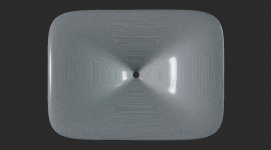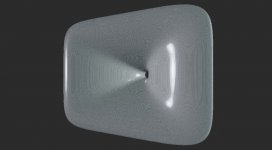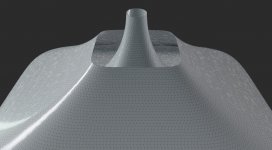I agree. Have you built the horn yet and taken measurements? I've done a 600Hz biradial that you may be interested in...
Joseph Crowe's DIY Speaker Building Blog: ES-600 Biradial Horn
Next week a 290Hz version goes on the CNC made from bamboo plywood. Still not 160 Hz.
I am working towards actualizing a horn. Joseph you were helping me (thank you) figure out some things early on about putting a ribbon in a horn and now that I am making moves to build my own horns for compression drivers, I can't remember why I gave up on that idea lol!
They look great Joseph. How low would the Axi go on the 290Hz one you are about to build? Do you think you would be able to build a 160Hz version for the Axi?I agree. Have you built the horn yet and taken measurements? I've done a 600Hz biradial that you may be interested in...
Joseph Crowe's DIY Speaker Building Blog: ES-600 Biradial Horn
Next week a 290Hz version goes on the CNC made from bamboo plywood. Still not 160 Hz.
KR
Keith.
That said, the sims of the docali's drba_swh_160_sq_pe_rb posted by DonVK look very promising. Thanks to both docali and Don for your efforts!
It would be interesting to see sims of an even shorter horn (T factor 5??).
Here is a horn with Tend=6. We cannot simulate every combination
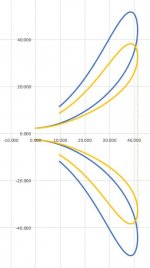
View attachment drba_swh_160_sq_peT6_rb.zip
We to encourage Don in this case. Some time ago he had the idea of a gmsh script solution. But to cover all possible variations it may be too complicated.
But I am sure that we will find something for you that theoretically works. To realize such a project would be your own and special challenge. But you should signal us if such horns are a real option for you.
But I am sure that we will find something for you that theoretically works. To realize such a project would be your own and special challenge. But you should signal us if such horns are a real option for you.
@camplo
Here is a small video Don prepared during our evaluation or call it proof of concept phase. This is a spherical wave horn with T=1, stretch factor of 1.5 and stereophic projection applied. I am quite sure that this horn would work nicely.
So, if you choose a constant T factor this is similar to the spherical wave horn properties and we know that these horns work as several Klangfilm cinema speakers used this horn type.
View attachment drba_swh_400_e_sf150_pf116_rb-merge-ExternalFields.zip
Here is a small video Don prepared during our evaluation or call it proof of concept phase. This is a spherical wave horn with T=1, stretch factor of 1.5 and stereophic projection applied. I am quite sure that this horn would work nicely.
So, if you choose a constant T factor this is similar to the spherical wave horn properties and we know that these horns work as several Klangfilm cinema speakers used this horn type.
View attachment drba_swh_400_e_sf150_pf116_rb-merge-ExternalFields.zip
Ok, just the hot results from the Sim for the 45 deg termination mouth horn:
The LF performance show some ripples but this seems to be normal for such a type. It should load very low. The oberservation spectrum views are not as nice as for the roll-back horns but this horn is a compromise. I expected even more artifacts because of the sudden mouth termination.
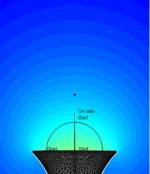
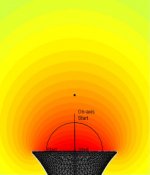
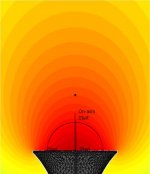
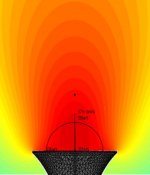
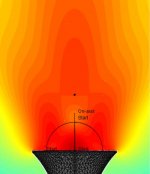
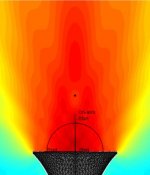
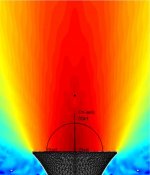
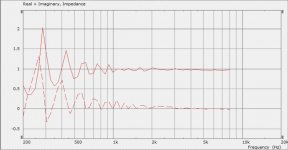
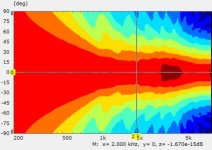
The LF performance show some ripples but this seems to be normal for such a type. It should load very low. The oberservation spectrum views are not as nice as for the roll-back horns but this horn is a compromise. I expected even more artifacts because of the sudden mouth termination.









Is this where the rollback ends?
The calculation is terminated at a certain distance from the inner horn walls. This is a compromise because of the meshing algorith within Meshlab. If I let it nearly merge then I get very nasty artifacts during meshing connecting the rollback-back to the inner horn section. So, this is clearly a compromise. But a person who is experienced with 3D software should be able to do some corrections or adding some surface parts.
drba_swh_300_sep_pe_rb - simulation
This is a follow up from the profile @docali provided in post #4303 Is it possible to cover the whole spectrum, high spl, low distortion with a 2-way?
This is my preferred profile. I've simulated several flavors of this, some to 16Khz. This simulation goes to 8Khz. It is very well behaved w.r.t impedance, polars, and field wavefronts. It also looks amazing.
This is a follow up from the profile @docali provided in post #4303 Is it possible to cover the whole spectrum, high spl, low distortion with a 2-way?
This is my preferred profile. I've simulated several flavors of this, some to 16Khz. This simulation goes to 8Khz. It is very well behaved w.r.t impedance, polars, and field wavefronts. It also looks amazing.
Attachments
-
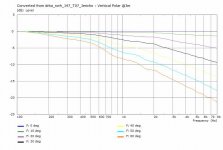 drba_swh_300_sep_pe_rb-vPolarCurve@3m.jpg38.7 KB · Views: 83
drba_swh_300_sep_pe_rb-vPolarCurve@3m.jpg38.7 KB · Views: 83 -
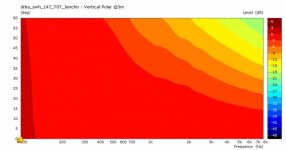 drba_swh_300_sep_pe_rb-vPolarContour@3m.jpg22.4 KB · Views: 100
drba_swh_300_sep_pe_rb-vPolarContour@3m.jpg22.4 KB · Views: 100 -
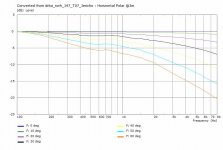 drba_swh_300_sep_pe_rb-hPolarCurve@3m.jpg38.7 KB · Views: 416
drba_swh_300_sep_pe_rb-hPolarCurve@3m.jpg38.7 KB · Views: 416 -
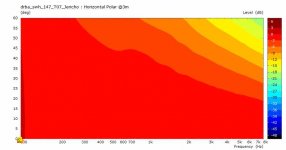 drba_swh_300_sep_pe_rb-hPolarContour@3m.jpg22.1 KB · Views: 409
drba_swh_300_sep_pe_rb-hPolarContour@3m.jpg22.1 KB · Views: 409 -
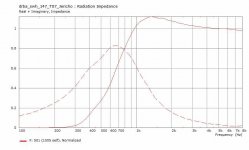 drba_swh_300_sep_pe_rb-RadImp.jpg33.2 KB · Views: 420
drba_swh_300_sep_pe_rb-RadImp.jpg33.2 KB · Views: 420 -
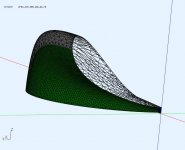 drba_swh_300_sep_pe_rb-Xsection.jpg65.9 KB · Views: 429
drba_swh_300_sep_pe_rb-Xsection.jpg65.9 KB · Views: 429 -
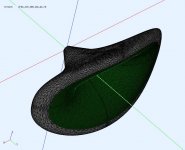 drba_swh_300_sep_pe_rb-3Dview.jpg77.8 KB · Views: 428
drba_swh_300_sep_pe_rb-3Dview.jpg77.8 KB · Views: 428
.. and the observation fields
Attachments
-
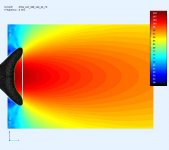 drba_swh_300_sep_pe_rb-Vfield@8KHz.jpg37.2 KB · Views: 62
drba_swh_300_sep_pe_rb-Vfield@8KHz.jpg37.2 KB · Views: 62 -
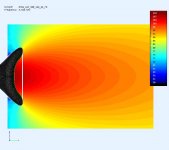 drba_swh_300_sep_pe_rb-Vfield@5KHz.jpg36.2 KB · Views: 50
drba_swh_300_sep_pe_rb-Vfield@5KHz.jpg36.2 KB · Views: 50 -
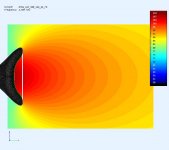 drba_swh_300_sep_pe_rb-Vfield@1.5KHz.jpg34.3 KB · Views: 51
drba_swh_300_sep_pe_rb-Vfield@1.5KHz.jpg34.3 KB · Views: 51 -
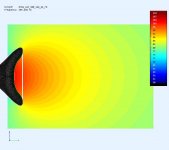 drba_swh_300_sep_pe_rb-Vfield@500Hz.jpg31.9 KB · Views: 55
drba_swh_300_sep_pe_rb-Vfield@500Hz.jpg31.9 KB · Views: 55 -
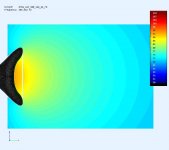 drba_swh_300_sep_pe_rb-Vfield@300Hz.jpg32.7 KB · Views: 66
drba_swh_300_sep_pe_rb-Vfield@300Hz.jpg32.7 KB · Views: 66 -
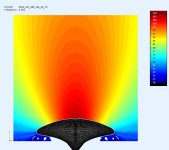 drba_swh_300_sep_pe_rb-Hfield@8KHz.jpg44.2 KB · Views: 67
drba_swh_300_sep_pe_rb-Hfield@8KHz.jpg44.2 KB · Views: 67 -
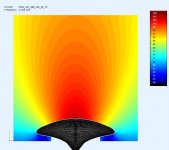 drba_swh_300_sep_pe_rb-Hfield@5KHz.jpg42.2 KB · Views: 67
drba_swh_300_sep_pe_rb-Hfield@5KHz.jpg42.2 KB · Views: 67 -
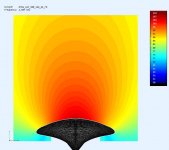 drba_swh_300_sep_pe_rb-Hfield@1.5KHz.jpg39.6 KB · Views: 66
drba_swh_300_sep_pe_rb-Hfield@1.5KHz.jpg39.6 KB · Views: 66 -
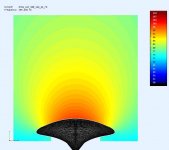 drba_swh_300_sep_pe_rb-Hfield@500Hz.jpg38.1 KB · Views: 70
drba_swh_300_sep_pe_rb-Hfield@500Hz.jpg38.1 KB · Views: 70 -
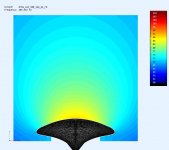 drba_swh_300_sep_pe_rb-Hfield@300Hz.jpg40.1 KB · Views: 88
drba_swh_300_sep_pe_rb-Hfield@300Hz.jpg40.1 KB · Views: 88
It looks and performs great! It probably does not go quite as low as camplo wants (yet).
Something in between that Jerico and this might be the compromise that camplo is after?
Ah well, maybe it would be what I were after in his shoes...
I love this shape though. It seems very well behaved.
Something in between that Jerico and this might be the compromise that camplo is after?
Ah well, maybe it would be what I were after in his shoes...
I love this shape though. It seems very well behaved.
Agreed, the parameters for this horn require higher XO then requested. However, all the parameters are adjustable so you could go lower by making this horn larger or longer. I just like the look and performance of an ellipse with projection, roll back and merge.
Who knows, maybe the compromise is a slightly higher XO to get a smaller horn.
P.S. the idea of printing a mold then fiberglassing the horn is a great idea. I would take it a step further and suggest 1/2 symmetry mold to get better mold release and create axial flanges to join and stiffen the part. Then fill the small gap with auto body filler and spot putty.
Who knows, maybe the compromise is a slightly higher XO to get a smaller horn.
P.S. the idea of printing a mold then fiberglassing the horn is a great idea. I would take it a step further and suggest 1/2 symmetry mold to get better mold release and create axial flanges to join and stiffen the part. Then fill the small gap with auto body filler and spot putty.
Maybe he could use the version with roll-back but with projection. The projection itself reduces the mouth diffraction effects.
Here two versions with increasing T and different stereographic projection applied and slightly lower cur-off:
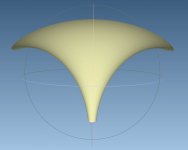
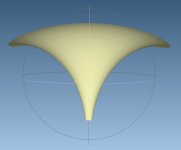
View attachment drba_swh_200_sf138_pf_pe_1.zip
View attachment drba_swh_200_sf138_pf141_pe_1.zip
Btw, with progressive expansion T the cut-off value has less meaning but it still determines the construction vector.
Here two versions with increasing T and different stereographic projection applied and slightly lower cur-off:


View attachment drba_swh_200_sf138_pf_pe_1.zip
View attachment drba_swh_200_sf138_pf141_pe_1.zip
Btw, with progressive expansion T the cut-off value has less meaning but it still determines the construction vector.
Last edited:
The horns of Jericho sim, that is of the very last iteration... Correct? For a tool, I'm loving the high directivity. All I see is a high level of direct signal and a low amount of room energy, as a result of the narrow polar. If there was a way to improve, while keeping the low loading, it would be icing on the cake.
The unique iteration above is pretty awesome too, but I can't tell what the dimensions are. I would interesting to know how big the above horn would have to be to load as low as Id like. I loaded them into Fusion360 yesterday but failed to scale it right, after I got the units correct. So the idea is to produce a horn for work and a horn that I would call "the peoples champ" ie the horn that you guys would chose if it was your system. ~630HZ is considered to be approximate center of 20hz and 20khz, so crossing there makes sense to me. Geddes called 700hz to about 7000hz hertz to be the critical range, so I'd think those ideas lend to another philosophy of ideal xover point and optimal performance.
Like you all, I have family duties and I'm not exactly laid off for the winter, yet. Headed to Lansing tomorrow actually. I really appreciate what you guys are doing for the project, I consider your time to be valuable and its really great that you'd spend some of it for my endeavor.
The unique iteration above is pretty awesome too, but I can't tell what the dimensions are. I would interesting to know how big the above horn would have to be to load as low as Id like. I loaded them into Fusion360 yesterday but failed to scale it right, after I got the units correct. So the idea is to produce a horn for work and a horn that I would call "the peoples champ" ie the horn that you guys would chose if it was your system. ~630HZ is considered to be approximate center of 20hz and 20khz, so crossing there makes sense to me. Geddes called 700hz to about 7000hz hertz to be the critical range, so I'd think those ideas lend to another philosophy of ideal xover point and optimal performance.
Like you all, I have family duties and I'm not exactly laid off for the winter, yet. Headed to Lansing tomorrow actually. I really appreciate what you guys are doing for the project, I consider your time to be valuable and its really great that you'd spend some of it for my endeavor.
Last edited:
Geddes called 700hz to about 7000hz hertz to be the critical range, so I'd think those ideas lend to another philosophy of ideal xover point and optimal performance.
Yes, it became clear to me that the goals in this thread are a long way from mine. The Jericho horn being shown has almost no directivity control and its very wide, neither of which is what I would want. Why CD is not a desirable characteristic here is a real puzzle to me since virtually all loudspeaker designers that I know, including Linkwitz, Toole, Olive, myself all agree that CD is a virtual requirement. So ignore this goal at your own peril.
Yes, it became clear to me that the goals in this thread are a long way from mine. The Jericho horn being shown has almost no directivity control and its very wide, neither of which is what I would want. Why CD is not a desirable characteristic here is a real puzzle to me since virtually all loudspeaker designers that I know, including Linkwitz, Toole, Olive, myself all agree that CD is a virtual requirement. So ignore this goal at your own peril.
I have a suggestion for you. Simply provide an appropriate STL file that fulfills camplos LF obejctives (can be crossed-over at 300-400Hz) and which has CD character. Then we will simulate it as a free-standing horn. Come on, show us that we all fail.
but I can't tell what the dimensions are.
Fair enough. Not sure how to watermark dimensions on them. These are OD.
The square horn : axial Z=56.6cm, Y=105.7cm, X=79.4cm
Is it possible to cover the whole spectrum, high spl, low distortion with a 2-way?
The Jericho horn : axial Z=90.7cm, Y=55.6cm
Is it possible to cover the whole spectrum, high spl, low distortion with a 2-way?
application - YouTube
The ellipse horn : axial Z=31.5cm, Y=75.4cm, X=44.4cm
Is it possible to cover the whole spectrum, high spl, low distortion with a 2-way?
All of them are large
- Home
- Loudspeakers
- Multi-Way
- Is it possible to cover the whole spectrum, high SPL, low distortion with a 2-way?
